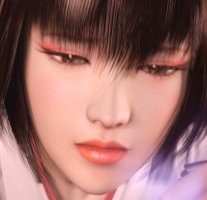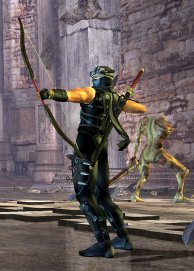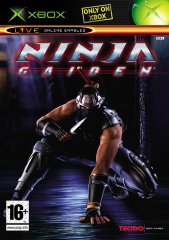Released in the spring of 2004, Ninja Gaiden is the best XBox game of 2004, probably the best XBox game bar none. That’s not to say you’ll like it of course. It is a game in a certain genre (actually it straddles a couple) and not everyone will find it compelling. But like it or not, you should recognize its quality.
First, an overview. Ninja Gaiden is the story of young ninja Ryu Hayabusa. His village, home of the Hayabusa clan, is sacked and burned by a fiend called Doku. Ryu’s sister dies in the attack. So too does Ryu; but he mysteriously revives thanks to ancient Ninja powers and goes off to take revenge. Armed with a variety of swords and projectile weapons, Ryu fights his way past innumerable fiends and monsters, kills Doku in both physical and spirit form, and finally encounters the source of all evil, the Holy Vigoor Emperor. Then there is a twist to the tale...
So that’s the plot, such as it is. But Ninja Gaiden is an action game. It’s about combat. And the combat is exceedingly well done. For starters, the game is graphically fast and responsive. The action has a rare fluidity, one that is lacking in rivals such as Prince of Persia Sands of Time, or Fable. This is important, because split-second responses are vital in Ninja Gaiden.

Ryu's sister. Taken from a cut scene early in the game, it's interesting on two counts. First, her anguished demise amid the flames of Ryu's village is what drives Ryu to revenge. Second, Tecmo games always feature beautiful women. The contrast between tender femininity and dark violence is all part of the experience.
Not too hard
A common complaint about the game is that it is too hard. Players reach the first boss, die in a few flicks of his Ninchaku (a weapon made from two metal sticks joined by a chain), and sometimes give up. This is intentional. The idea is that you have to study your enemies in order to survive. Watch how they fight, work out weaknesses, and plan your response. Wading in and hammering the buttons won’t do.
So what options are there? Many. First, Ryu must learn how to avoid being hit. He can block, roll away, or even run round the walls. Second, Ryu has a huge variety of possible attacks. Each weapon in the game has a different set of capabilities, activated by special button sequences, and known by evocative names such as Early Winter Rain or Divine Cicada Slash. In addition, when a creature dies its expiring soul leaves floating power-ups called Essence. Holding a button down allows Ryu to charge his weapon for what Ninja Gaiden calls “ultimate techniques”. Some of these are spectacular, and you will see Ryu despatch his opponents in a haze of flashing blades. Time it right, and each ultimate attack can charge up the next, allowing Ryu to devastate entire groups. He also has the ability to climb walls and dive down for a supercharged attack. Get to grips with all this, and you discover that Ninja Gaiden is not too hard, merely a game that repays the effort of learning how to play.

Ryu draws his bow while a decapitated but undead zombie prepares a blow from the rear.
A compelling game world
Ninja Gaiden's game world is large, beautiful, and richly detailed. Although the plot is fairly linear, you have a lot of freedom to wander as you will. Scenes include the Hayabusa village and an airship in flight, but most of the action takes place in the Vigoor stronghold in and around the town of Tairon. It has a convincing mediaeval atmosphere, and no two streets or courtyards look the same. Then there is the monastery, with its sense of huge scale. One of the weird things about this world is that along with swords and magic, it has industrial technology as well. There’s not only the airship, but also trains, tanks, guns and helicopters. I’m afraid you have to suspend disbelief a little, as Ryu shrugs off machine-gun bullets and successfully takes on a military helicopter with his longbow, but it all adds to the variety. Not to mention the vast underground scenes, complete with temples, catacombs and crypts, or the labyrinth, or the moats, or the pyramid, or the trips to the fiendish underworld. All told, it is a work of art.

This flame dragon is a fine specimem, but with a vicious bite.
Creatures galore
The scenery is good, but Ninja Gaiden’s creatures deserve special mention. They are crafted in loving detail, especially the boss characters. Each creature has its own set of powers and special moves, and there’s enough variety that combat rarely seems repetitive. I’m not sure what to single out here: the skeletal zombies that move ponderously but pack a huge punch when they hit; the Alma fiend with lightning-fast moves and a throw that leaves Ryu near-lifeless; the huge bony skeletal bird that shoots lasers; spirit Doku with the sword that sucks your health while replenishing his; it just goes on. Each boss needs a different strategy, which brings me on to another unusual thing. With most games, the tips, walkthroughs and cheat-sheets take away all the fun, but with Ninja Gaiden that’s not so. There are no actual cheats that anyone knows about. Most of the fights remain challenging even after you read the tips, and sharing combat strategies is almost part of the game.
Play in Ninja Gaiden is interspersed with cut scenes. Clearly the developers thought these were good, since once completed you can view them from the main menu in theatre mode. Some of these scenes are indeed special. The word that comes to mind is “understated”, which is not usually something that comes to mind when describing a console game. But listen to the way Rachel says Ryu’s name near to the end – one word, but laden with emotion. Understatement applies elsewhere in Ninja Gaiden too. During the game, the camera occasionally pans over a particular item or entrance for no apparent reason. That’s usually a clue about where to go next. Similarly, some buildings are marked with a faint shade of blue; again it means you should check it out. Unobtrusive but effective.
Hurricane packs
Ninja Gaiden has received free updates on two occasions, delivered via XBox live and free for the download, though sadly so far denied to non-subscribers. Known as the Hurricane Packs, they say a lot about the game and its philosophy. Since the game has been widely accused of being too difficult, you had to smile when Hurricane Pack 1 upped the difficulty a little further. It also introduced a delightful new weapon and some new monsters, such as a cat-like creature with extraordinary quick moves. The Hurricane Pack actually seemed to tweak the game’s graphics, making it even faster and more responsive. There’s also a crucial new move, called Intercept, that lets you block any attack and counter with one of your own. Getting the timing right is hard, but that’s true to form.
Hurricane Pack 2 was different. Most of the game takes place in a single small arena, where you fight wave upon wave of fabulous creatures, some of them completely new. This is an intense gaming experience. The final boss is a catwoman equipped with a whip, and frankly if you can beat her you have every right to feel proud. Too hard? Ninja Gaiden creator Tomonobu Itagaki: “We are creating the Hurricane Pack for ourselves rather than for our fans.”
The flaws and the final word
So what about the flaws? Well, the plot is rather silly if you stop to think about it. Ryu takes a long time and a lot of effort to go round in circles. The same button is used for swinging swords and for opening doors, which leads to some wrong moves from time to time. Some say the camera is poor, but I can’t often fault it – occasionally it’s hard to see what’s going on, but then again this is war. The game is sometimes repetitive, especially in sections where enemies spawn, so you have the same fights multiple times. On the other hand, without these sections it would be hard for Ryu to find enough yellow essence, which is used as the currency for purchasing weapons and potions. Some fights are too easy, and occasionally Ninja Gaiden oversteps the boundary between challenge and annoyance (red room anyone?).
But frankly, these are minor blemishes. This was a wonderful game on first release; with its two add-on packs it is pure XBox happiness.
Links
Buy Ninja Gaiden at Amazon.com
Buy Ninja Gaiden at Amazon.co.uk
Copyright Tim Anderson 2nd December 2004. All rights reserved.
